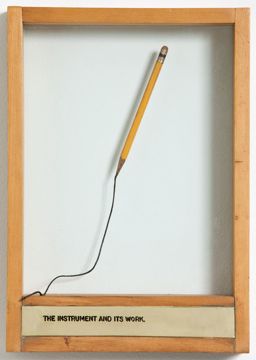If you get the opportunity in the next month, take some time to see On Line: Drawing Through the 20th Century at the Museum of Modern Art. And if you happen to be there today or this Friday, stop by and say hello since I will be visiting with two of my introductory Studio Art classes. We will be on an adventure of sorts, looking into the history of drawing and simultaneously exploring how an exhibition about line can influence an upcoming unit on sculpture.
From the moment you enter the show, you’re asked to reconsider what drawing is and has become. Works like Luis Camnitzer’s “Two Parallel Lines” and Mimi Gellman’s “nightdrawing 1” incorporate mixed-media, installation, performance and photography, for example. Even video plays into the mix of defining and redefining drawing, such as Edith Dekyndt’s “A Is Hotter Than B”, where smoke forms the lines that slowly move through the 9-minute loop.
While MoMA states that, “On Line argues for an expanded history of drawing that moves off the page into space and time,” this is a show about line first and perhaps the history of drawing second. Nevertheless, it’s an amazing survey show that allows for students to examine their preconceptions, and perhaps even their misconceptions, about drawing today. It takes the most fundamental element of design and literally blows it up six ways to Sunday. And that’s why I am so interested in sharing this exhibit with my students. While we could take most of our time to view the blockbuster Abstract Expressionist New York, it feels like a worthwhile challenge to see if we can not only expand our collective ideas about drawing, but also consider how it can shape our work with sculpture.
During our visit, students will be asked to sketch, answer some reflective questions and begin thinking about how this show can inspire a sculpture that simply begins with a line. Our visit incorporates active viewing vs. passive looking. The sculpture students eventually create may be thematic, but it must begin with a line. It may wind up being representational or abstract, but it must be influenced by something experienced, or realized, during the visit. And after spending some focused time with works by Trisha Brown, Julie Mehretu, Marcel Duchamp, Eva Hesse, Arturo Herrera, Robert Rauschenberg, Cecilia Vicuña, Emily Kam Kngwarray and Ellen Gallagher, to name just a small fraction of the artists featured, I am sure we will have plenty to work with.
Perhaps we will see you there?




